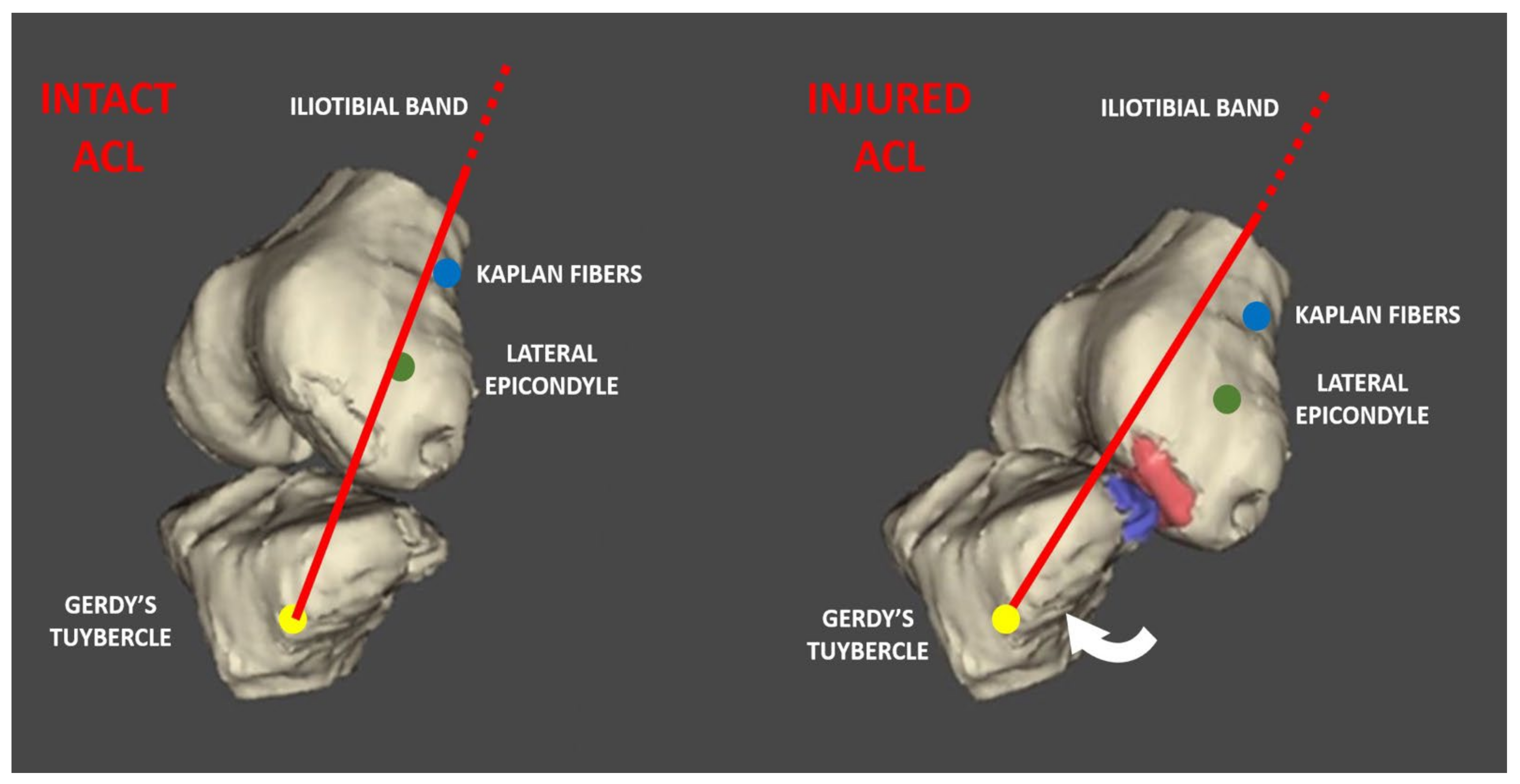Will the Kaplan Fiber Complex Be the ‘‘New Anterolateral Ligament’’? Insights from Direct Surgical Exploration in the Context of ACL Injury and Reconstruction
Author Contributions
Funding
Conflicts of Interest
References
- Kaplan, E.B. The iliotibial tract; clinical and morphological significance. J. Bone Jt. Surg. 1958, 40, 817–832. [Google Scholar] [CrossRef]
- Godin, J.A.; Chahla, J.; Moatshe, G.; Kruckeberg, B.M.; Muckenhirn, K.J.; Vap, A.R.; Geeslin, A.G.; LaPrade, R.F. A comprehensive reanalysis of the distal iliotibial band: Quantitative anatomy, radiographic markers, and biomechanical properties. Am. J. Sports Med. 2017, 45, 2595–2603. [Google Scholar] [CrossRef] [PubMed]
- Lobenhoffer, P.; Posel, P.; Witt, S.; Piehler, J.; Wirth, C.J. Distal femoral fixation of the iliotibial tract. Arch. Orthop. Trauma Surg. 1987, 106, 285–290. [Google Scholar] [CrossRef] [PubMed]
- Terry, G.C.; Hughston, J.C.; Norwood, L.A. The anatomy of the iliopatellar band and iliotibial tract. Am. J. Sports Med. 1986, 14, 39–45. [Google Scholar] [CrossRef] [PubMed]
- Vieira, E.L.C.; Vieira, E.Á.; da Silva, R.T.; dos Santos Berlfein, P.A.; Abdalla, R.J.; Cohen, M. An anatomic study of the iliotibial tract. Arthroscopy 2007, 23, 269–274. [Google Scholar] [CrossRef] [PubMed]
- Geeslin, A.G.; Chahla, J.; Moatshe, G.; Muckenhirn, K.J.; Kruckeberg, B.M.; Brady, A.W.; Coggins, A.; Dornan, G.J.; Getgood, A.M.; Godin, J.A.; et al. Anterolateral Knee Extra-articular Stabilizers: A Robotic Sectioning Study of the Anterolateral Ligament and Distal Iliotibial Band Kaplan Fibers. Am. J. Sports Med. 2018, 46, 1352–1361. [Google Scholar] [CrossRef] [PubMed]
- Berthold, D.P.; Willinger, L.; LeVasseur, M.R.; Marrero, D.E.; Bell, R.; Muench, L.N.; Kane, Z.; Imhoff, A.B.; Herbst, E.; Cote, M.P.; et al. High Rate of Initially Overlooked Kaplan Fiber Complex Injuries in Patients with Isolated Anterior Cruciate Ligament Injury. Am. J. Sports Med. 2021, 49, 2117–2124. [Google Scholar] [CrossRef] [PubMed]
- Balendra, G.; Willinger, L.; Pai, V.; Mitchell, A.; Lee, J.; Jones, M.; Williams, A. Anterolateral complex injuries occur in the majority of ‘isolated’ anterior cruciate ligament ruptures. Knee Surg. Sports Traumatol. Arthrosc. 2022, 30, 176–183. [Google Scholar] [CrossRef] [PubMed]
- Lynch, T.B.; Bernot, J.M.; Oettel, D.J.; Byerly, D.; Musahl, V.; Chasteen, J.; Antosh, I.J.; Patzkowski, J.C.; Sheean, A.J. Magnetic resonance imaging does not reliably detect Kaplan fiber injury in the setting of anterior cruciate ligament tear. Knee Surg. Sports Traumatol. Arthrosc. 2022, 30, 1769–1775. [Google Scholar] [CrossRef] [PubMed]
- Devitt, B.M.; Al’khafaji, I.; Blucher, N.; Batty, L.M.; Murgier, J.; Webster, K.E.; Feller, J.A. Association Between Radiological Evidence of Kaplan Fiber Injury, Intraoperative Findings, and Pivot-Shift Grade in the Setting of Acute Anterior Cruciate Ligament Injury. Am. J. Sports Med. 2021, 49, 1262–1269. [Google Scholar] [CrossRef] [PubMed]
- Marcacci, M.; Zaffagnini, S.; Iacono, F.; Neri, M.P.; Loreti, I.; Petitto, A. Arthroscopic intra- and extra-articular anterior cruciate ligament reconstruction with gracilis and semitendinosus tendons. Knee Surg. Sports Traumatol. Arthrosc. 1998, 6, 68–75. [Google Scholar] [CrossRef] [PubMed]
- Grassi, A.; Costa, G.G.; Cialdella, S.; Lo Presti, M.; Neri, M.P.; Zaffagnini, S. The 90-day Readmission Rate after Single-Bundle ACL Reconstruction Plus LET: Analysis of 2,559 Consecutive Cases from a Single Institution. J. Knee Surg. 2021, 34, 978–986. [Google Scholar] [CrossRef] [PubMed]
- Della Villa, F.; Buckthorpe, M.; Grassi, A.; Nabiuzzi, A.; Tosarelli, F.; Zaffagnini, S.; Virgile, A.; Della Villa, S. Infographic. Systematic video analysis of ACL injuries in professional male football (soccer): Injury mechanisms, situational patterns and biomechanics study on 134 consecutive cases. Br. J. Sports Med. 2020, 55, 405–406. [Google Scholar] [CrossRef] [PubMed]
- Della Villa, F.; Tosarelli, F.; Ferrari, R.; Grassi, A.; Ciampone, L.; Nanni, G.; Zaffagnini, S.; Buckthorpe, M. Systematic Video Analysis of Anterior Cruciate Ligament Injuries in Professional Male Rugby Players: Pattern, Injury Mechanism, and Biomechanics in 57 Consecutive Cases. Orthop. J. Sports Med. 2021, 9, 23259671211048182. [Google Scholar] [CrossRef] [PubMed]
- Grassi, A.; Tosarelli, F.; Agostinone, P.; Macchiarola, L.; Zaffagnini, S.; Della Villa, F. Rapid Posterior Tibial Reduction After Noncontact Anterior Cruciate Ligament Rupture: Mechanism Description from a Video Analysis. Sports Health 2020, 12, 462–469. [Google Scholar] [CrossRef] [PubMed]
- Lucarno, S.; Zago, M.; Buckthorpe, M.; Grassi, A.; Tosarelli, F.; Smith, R.; Della Villa, F. Systematic Video Analysis of Anterior Cruciate Ligament Injuries in Professional Female Soccer Players. Am. J. Sports Med. 2021, 49, 1794–1802. [Google Scholar] [CrossRef] [PubMed]
- Grassi, A.; Agostinone, P.; Di Paolo, S.; Lucidi, G.A.; Macchiarola, L.; Bontempi, M.; Marchiori, G.; Bragonzoni, L.; Zaffagnini, S. Knee position at the moment of bone bruise could reflect the late phase of non-contact anterior cruciate ligament injury rather than the mechanisms leading to ligament failure. Knee Surg. Sports Traumatol. Arthrosc. 2021, 29, 4138–4145. [Google Scholar] [CrossRef] [PubMed]
- Koga, H.; Nakamae, A.; Shima, Y.; Bahr, R.; Krosshaug, T. Hip and Ankle Kinematics in Noncontact Anterior Cruciate Ligament Injury Situations: Video Analysis Using Model-Based Image Matching. Am. J. Sports Med. 2018, 46, 333–340. [Google Scholar] [CrossRef] [PubMed]

Publisher’s Note: MDPI stays neutral with regard to jurisdictional claims in published maps and institutional affiliations. |
© 2022 by the authors. Licensee MDPI, Basel, Switzerland. This article is an open access article distributed under the terms and conditions of the Creative Commons Attribution (CC BY) license (https://creativecommons.org/licenses/by/4.0/).
Share and Cite
Grassi, A.; Caravelli, S.; Mosca, M.; Zaffagnini, S. Will the Kaplan Fiber Complex Be the ‘‘New Anterolateral Ligament’’? Insights from Direct Surgical Exploration in the Context of ACL Injury and Reconstruction. J. Clin. Med. 2022, 11, 4842. https://doi.org/10.3390/jcm11164842
Grassi A, Caravelli S, Mosca M, Zaffagnini S. Will the Kaplan Fiber Complex Be the ‘‘New Anterolateral Ligament’’? Insights from Direct Surgical Exploration in the Context of ACL Injury and Reconstruction. Journal of Clinical Medicine. 2022; 11(16):4842. https://doi.org/10.3390/jcm11164842
Chicago/Turabian StyleGrassi, Alberto, Silvio Caravelli, Massimiliano Mosca, and Stefano Zaffagnini. 2022. "Will the Kaplan Fiber Complex Be the ‘‘New Anterolateral Ligament’’? Insights from Direct Surgical Exploration in the Context of ACL Injury and Reconstruction" Journal of Clinical Medicine 11, no. 16: 4842. https://doi.org/10.3390/jcm11164842




